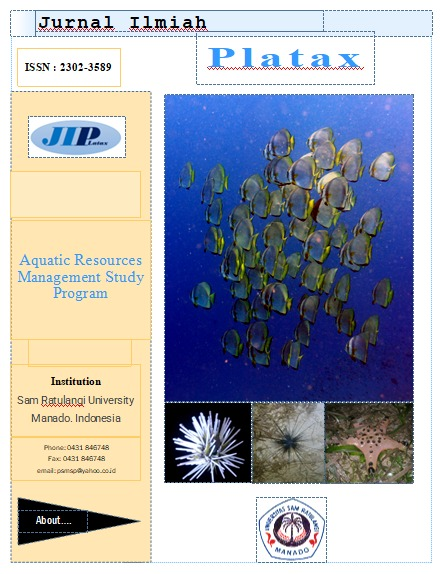Phycoeritryn Pigments In Carrageenan From Algae Kappaphycus alvarezii (Doty) Doty 1996
DOI:
https://doi.org/10.35800/jip.v10i2.42456Keywords:
Carrageenan, phycoerythrin pigments, Kappaphycus alvarezii, Halymenia durvillei, viscosity, gel strength.Abstract
Kappaphycus alvarezii is a marine alga cultivated in Indonesia and produces carrageenan. Carrageenan is a product used in the cosmetic, food, and pharmaceutical industries. This study aimed to test the viscosity and gel strength of refined carrageenan with the addition of natural dye phycoerythrin from the algae Halymenia durvillei with different concentrations. Refine carrageenan was made using alkaline solvents of 4% NaOH and 5% KOH and then boiled using a pressure cooker. The results showed a reddish color change in the pure carrageenan refinement with the addition of phycoerythrin pigment, especially at a concentration of 50%. The average value of refined carrageenan viscosity for 4% NaOH concentration was 49.22 – 50.27 cP, and 5% KOH concentration ranged from 47.16 – 50.12 cP. Testing the gel strength of the refined carrageenan, the average NaOH 4% was 72.67 – 82.00 mm/g/sec, and the 5% KOH concentration was 81.00 – 81.78 mm/g/sec. The addition of phycoerythrin pigment to refine carrageenan had no effect on viscosity and gel strength. Drying at a temperature of 100oC obtained a water content of semi-refined carrageenan between 2.91 - 4.38%, this value is in accordance with the standard for carrageenan water content from FAO, which is a maximum of 12%.
Keywords: Carrageenan, phycoerythrin pigments, Kappaphycus alvarezii, Halymenia durvillei, viscosity, gel strength.
Abstrak
Kappaphycus alvarezii merupakan alga laut yang dibudidayakan di Indonesia dan penghasil karagenan. Karagenan merupakan suatu produk yang digunakan dalam industri kosmetik, makanan, dan juga farmasi. Tujuan dari penelitian adalah menguji viskositas dan kekuatan gel terhadap karagenan refine yang ditambahkan pigmen fikoeritrin dari alga Halymenia durvillei dengan perbedaan konsentrasi. Karagenan refine dibuat dengan menggunakan pelarut alkali NaOH 4% dan KOH 5% selanjutnya direbus dengan tekanan tinggi. Hasil yang didapat menunjukan bahwa terjadi perubahan warna kemerahan pada karagenan refine dengan penambahan pigmen fikoeritrin, terutama pada konsentrasi 50%. Nilai rata-rata viskositas karagenan refine untuk konsentrasi NaOH 4% adalah 49.22 – 50.27 cP, dan konsentrasi KOH 5% berkisar 47.16 – 50.12 cP. Pengujian kekuatan gel pada karagenan refine diperoleh rata-rata NaOH 4% sebesar 72.67 – 82.00 mm/g/det dan konsentrasi KOH 5% adalah 81.00 – 81.78 mm/g/det. Penambahan pigmen pada karagenan refine tidak berpengaruh pada viskositas dan kekuatan gel. Pengeringan dengan suhu 100OC memperoleh kadar air pada karagenan semi refine antara 2.91 - 4.38%, nilai tersebut telah sesuai dengan standar kadar air karagenan dari FAO yaitu maksimum 12%.
Kata kunci: Karagenan, pigmen fikoeritrin, Kappaphycus alvarezii, Halymenia durvillei, viskositas, kekuatan gel.Â
References
Abfa, I. K., Prasetyo, B., & Susanto, A. (2013). Karakteristik Fikoeritrin Sebagai Pigmen Asesoris Pada Rumput Laut Merah, Serta Manfaatnya. Proceeding Biology Education Conference. 10. Surakarta: Universitas Sebelas Maret.
Anwar, F., Djunaedi, A., & Gunawan, W. (2013). Pengaruh Konsentrasi Berbeda Terhadap Kualitas Alginat Rumput Laut Coklat Sargassum Duplicatum. Journal Of Marine Research , 7-14.
Ega, L., Lopulalan, C. G., & Meiyasa, F. (2016). Kajian Mutu Karaginan Rumput Laut Eucheuma cottonii Berdasarkan Sifat Fisiko-Kimia pada Tingkat Konsentrasi Kalium Hidroksida (KOH) yang Berbeda. Jurnal Aplikasi Teknologi Pangan, 5(2), 38-44.
Ferdouse, F., Holdt, S. L., Smith, R., Murua, P., & Yang, Z. (2018). The global status of seaweed production, trade, and utilization (Vol. 124). Rome: Food and Agriculture Organization of The United Nations.
Gerung, M. S., Montolalu, R. I., Lohoo, H. J., Dotulong, V., Taher, N., Mentang, F., & Sanger, G. (2019). Pengaruh Konsentrasi Pelarut Dan Lama Ekstraksi Pada Produksi Karagenan. Jurnal Media Teknologi Hasil Perikanan, 7(1), 25-31.
Mantiri, D. M., Kepel, R. C., Boneka, F. B., & Sumilat, D. A. (2021). Phytochemical screening, antioxidant and antibacterial tests on red algae, Halymenia durvillaei, and phycoerythrin pigments. AACL Bioflux, 14(6).
Pudjiastuti, S. (2017). Laporan Kineja KKP 2016. Jakarta: Kementerian Kelautan dan Perikanan.
Romenda, A. P., Pramesti, R., & Susanto, A. (2013). Pengaruh Perbedaan Jenis Dan Konsentrasi Larutan Alkali Terhadap Kekuatan Gel Dan Viskositas Karaginan Kappaphycus alvarezii, Doty. Journal Of Marine Research, 2(1), 127-133.
Rose, C. (2016). Seaweed and Co. Retrieved November 4, 2021, from Seaweed Supply History:https://www.seaweedandco.com/seaweed-supply-history/
Saputra, S. A., Yulian, M., & Nisahi, K. (2021). Karakteristik dan Kualitas Mutu Karaginan Rumput Laut di Indonesia. Lantanida Journal, 9(1), 1-92.
Steel, R., & Torrie, J. (1989). Prinsip dan Prosedur Statistika. Jakarta: PT. Gramedia Pustaka Utama.
Towle, G. (1973). Carrageenan. In R. Whistler, Industrial Gums. New York: Academic Press.
Tuiyo, R. (2016). Budidaya Alga Laut (Kappaphycus alvarezii) dalam Kantong Plastik dengan Menggunakan Teknologi Basningro. Gorontalo: UNG Press.
Tunggal, W. W., & Hendrawati, T. Y. (2015). Pengaruh Konsentrasi KOH pada Ekstraksi Rumput Laut (Eucheuma cottonii) dalam Pembuatan Karagenan. Konversi, 4(1), 32-39.
Downloads
Published
How to Cite
Issue
Section
License
COPYRIGHT
Authors who publish with this journal agree to the following terms:
Authors hold their copyright and grant this journal the privilege of first publication, with the work simultaneously licensed under a Creative Commons Attribution License that permits others to impart the work with an acknowledgment of the work's origin and initial publication by this journal.
Authors can enter into separate or additional contractual arrangements for the non-exclusive distribution of the journal's published version of the work (for example, post it to an institutional repository or publish it in a book), with an acknowledgment of its underlying publication in this journal.
Authors are permitted and encouraged to post their work online (for example, in institutional repositories or on their website) as it can lead to productive exchanges, as well as earlier and greater citation of the published work (See The Effect of Open Access).




















